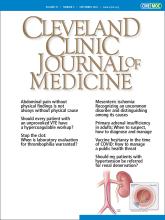
The first real clinical book (distinct from the usual textbook) I recall reading on a regular basis was Early Diagnosis of the Acute Abdomen1 by Sir Vincent Zachary Cope, MS, MD. The original text was written in 1921, and there are now more than 20 editions with updates. Apparently, I was not alone in my appreciation.
I recall first using Cope’s Early Diagnosis as a medical student while on my third-year general surgery rotation. I’ve given away copies to trainees and then purchased newer editions, which I referred to frequently when I was “moonlighting” in the emergency department. Since then, I have used it occasionally, such as when attending on a general medicine inpatient service or when faced with patients experiencing confusing abdominal symptoms. Books like this inspire my respect for those clinical diagnosticians able to separate the wheat from the chaff in the medical history and physical examination and propose a clinical diagnosis that can then be confirmed using appropriate testing and interventions. But what about clinical scenarios when the physical examination is not helpful?
Given the limitations of diagnostic testing available at the time Early Diagnosis was first published, Cope, and other authors since,2 emphasized the need for high clinical suspicion in the appropriate clinical setting in order to make the diagnosis of mesenteric ischemia. The classic presentation of acute mesenteric ischemia is often described as severe and sudden pain out of proportion to physical examination findings. Thus, especially in stoic or perceived histrionic patients, the diagnosis can easily be delayed or missed entirely. As discussed by Wu and Nanjundappa3 in this issue of the Journal, a shared etiologic factor for many patients with acute mesenteric ischemia is the presence of atherosclerotic cardiovascular disease, which translates into this condition being more prevalent in older patients. There are, however, uncommon clinical conditions that can cause acute bowel ischemia in younger patients as well,4 posing a diagnostic challenge in a young patient with abdominal pain out of proportion to laboratory abnormalities or findings on physical examination that raises the red flag for “drug-seeking behavior” in emergency rooms. It takes vigilance, clinical adroitness, and often some luck to make the correct early diagnosis before bowel infarction occurs when the patient presents with localized abdominal pain, rebound tenderness, a rising lactate level and anion gap, and a dropping bicarbonate. I am always wary of the “drug-seeking behavior” label, particularly in the acute setting.
Chronic mesenteric ischemia can be even more difficult to diagnose. It can progress insidiously. Patients may present with months (or longer) of chronic abdominal pain, also with the relative absence of abdominal physical findings. In older patients, chronic mesenteric ischemia often results from progressing atherosclerotic disease, but in younger patients it could be due to systemic inflammatory vascular disease, hypercoagulable disorders, or noninflammatory syndromes that can cause extrinsic occlusion of the mesenteric vessels. The last of these 3 includes retroperitoneal fibrosis and the difficult-to-diagnose median arcuate ligament syndrome.5 Patients with chronic occlusive disease may experience postprandial abdominal cramping (abdominal angina) and with discussion may describe food avoidance and resultant weight loss. These last 2 symptoms are characteristic but not specific, as they also can be strikingly apparent in patients with gastroparesis, gastric cancer, and eosinophilic esophagitis.
The symptoms, laboratory findings, and physical examination of patients with undiagnosed mesenteric ischemia in the real world can be vague and unenlightening. But the sooner the diagnosis is considered and vascular imaging is obtained, the sooner appropriate management decisions can be made. The brief review in this issue3 is worth reading as a reminder of this serious clinical entity, which is characterized by a disconnect between the patient’s symptoms and the physical examination—a disconnect that, when not recognized, can contribute to a catastrophic outcome.
- Copyright © 2024 The Cleveland Clinic Foundation. All Rights Reserved.






